Large companies, small businesses, and freelancers can all greatly benefit from tracking time. Understanding and improving your time management can boost your business’s profitability.
While hunting for the best time tracking app for your business, you may have come across Toggl Track and the Timely app.
They’re both good options for tracking time, but which is the best?
In this article, we’ll explore in-depth the differences between Toggl vs Timely. We’ll also cover the limitations of the two tools and show you a better alternative.
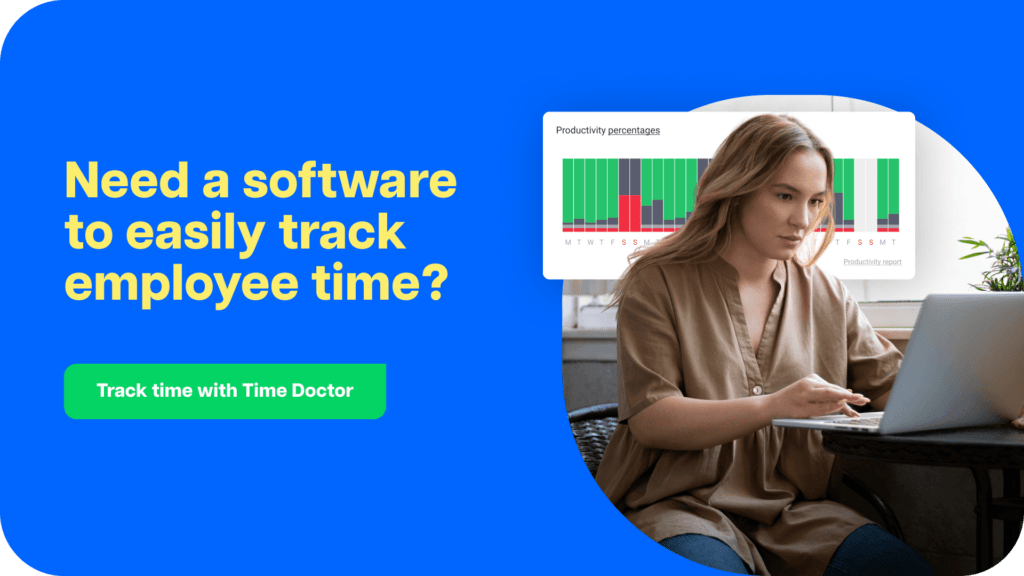
Table of Contents
- Toggl vs Timely: A detailed comparison
- 3 key limitations of Toggl and Timely
- A better time and productivity tracking alternative: Time Doctor
Toggl vs Timely: A detailed comparison
Before we dive into a detailed feature comparison, let’s learn more about these two solutions.
What is Toggl?
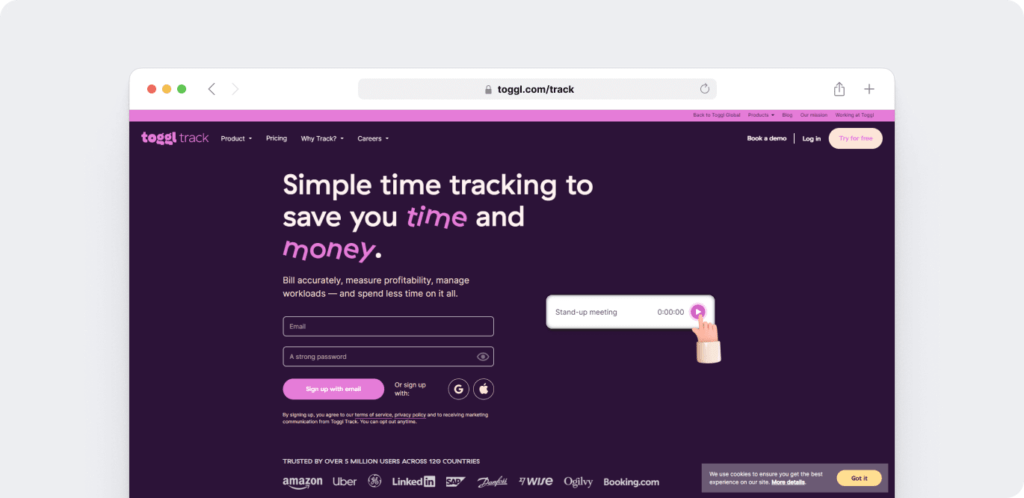
Toggl Track is a time tracking tool in the Toggl suite of work apps. It offers multiple ways to track time, as well as other handy features like expense tracking and reporting.
You can use Toggl via a:
- Mobile app (Android and iOS devices).
- Desktop app (Windows and Mac).
- Web app.
- Firefox and Chrome extension.
Read this comprehensive Toggl Track review to learn more about the app.
What is Timely?
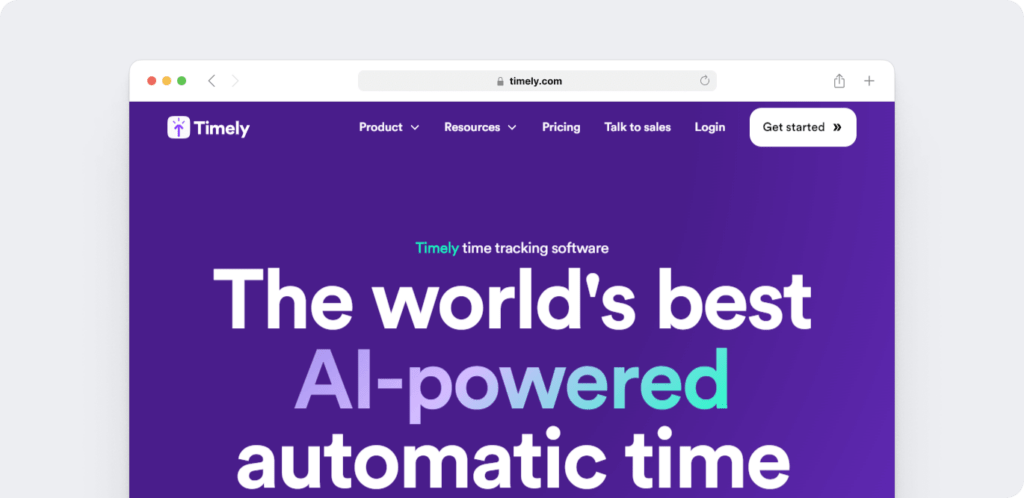
The Timely app, created by Memory, takes an unconventional approach to track employee work hours and activities.
It’s an automatic time tracker that records all daily web and app usage activity. However, everything is kept private to each employee until they choose what to share with management. It also has some project management functionalities to promote good teamwork.
Timely is available as a:
- Mobile app (Android and iOS devices) for your smartphone, tablet, iPhone, or iPad.
- Desktop app (Windows and Mac).
- Web app.
Now, let’s see how Toggl and Timely’s features compare:
| Feature | Toggl | Timely |
|---|---|---|
| Time Tracking | Manual and automatic tracking, Pomodoro timer, suggestions and reminders | Automatic tracking, private records for employees, AI-generated timesheets |
| Project Management | Project dashboards, timeline forecasts, billable rates, expense tracking, budget notifications | Time and labor cost budgets, notifications for budget approaches, past project expense records, task allocation |
| Reporting | Customizable reports (detailed, weekly, summary), export as CSV/PDF, shareable, scheduled reports | Custom reports with filters, templates, branding, live and snapshot designs, export as XLS/CSV/PDF |
| Integrations | 10 native integrations, browser extension for 100+ apps, API for custom connections, Zapier for automation | 15 native integrations, Zapier for additional connections, integrates with Toggl for easy data transfer |
| Pricing | Free plan for up to 5 users; Paid plans start at $10/user per month for unlimited projects and clients | No free plan; 14-day trial available, Starter plan at $10/user per month for 50 projects and three teams |
1. Time tracking
Here’s a look at how these two apps track time:
A. Toggl
Toggl Track offers several different ways to track time. Employees can do so:
- Manually using a simple time clock or Pomodoro timer.
- Automatically, when the app creates time entries based on web and app usage.
- By creating a time entry from a Google Calendar event.
You can also receive tracking suggestions and reminders, so you never forget to track time.
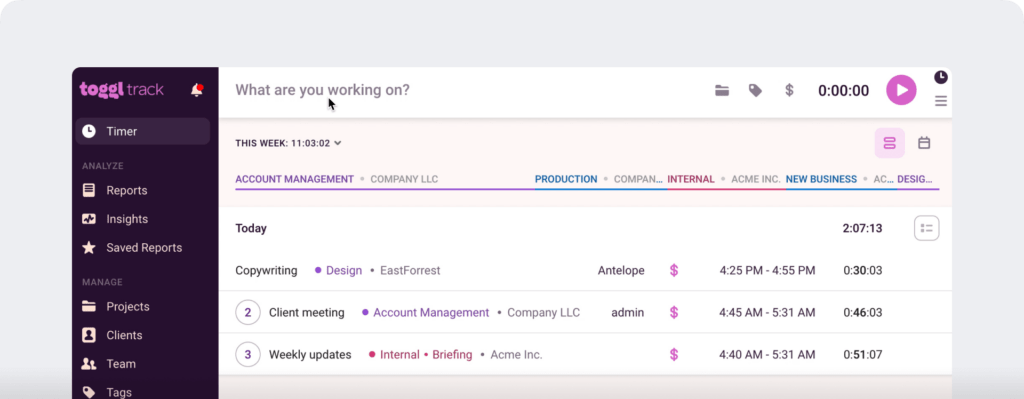
B. Timely
Timely is an automatic-only time tracker. Here’s how employees track their working hours:
Step 1: Set up the integration with the Memory app to activate automatic tracking.
Step 2: Receive a private record of all your daily activities (or “Memories”), tracked automatically based on web and app usage.
Step 3: Decide which Memories you’d like to appear on your timesheet, and add them with a drag-and-drop tool.
Alternatively, allow the Timely AI to draft a timesheet for you to approve.
This way, employees control what information is visible to managers.
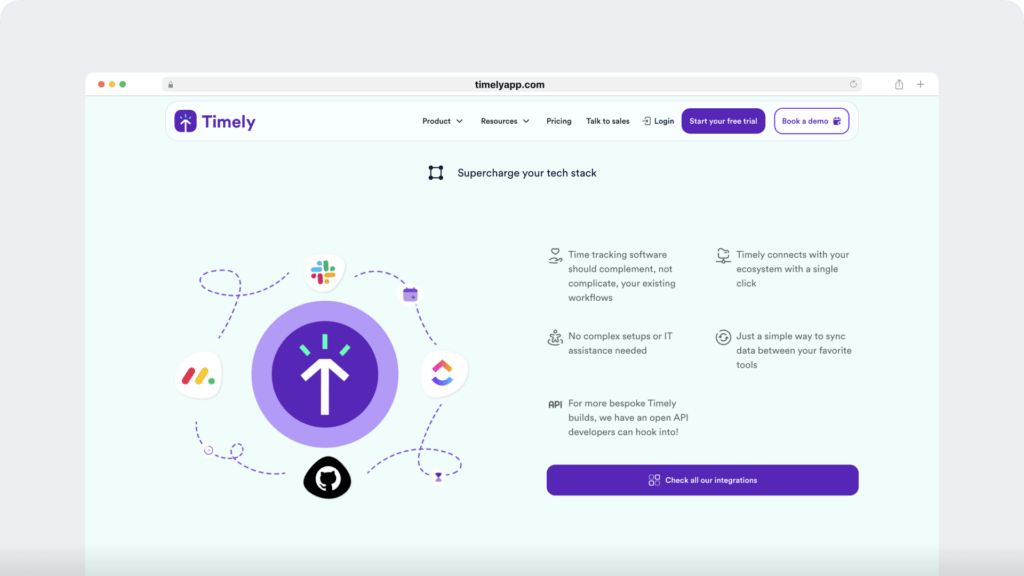
Summary: Time tracking
Toggl offers both manual and automatic tracking (& a Pomodoro timer), while Timely is a fully-automated tracker.
2. Project management
Both these apps have some functionalities of a task management and project management tool. Here’s the low-down:
A. Toggl
Toggl Track’s project management features mainly involve monitoring project budgets:
- Provides project dashboards with timeline forecasts and budgets.
- Allows you to set billable rates for different projects or team members.
- Offers expense tracking by keeping checks on billable rates and labor costs.
- Sends notifications when a project approaches the time or labor cost budget.
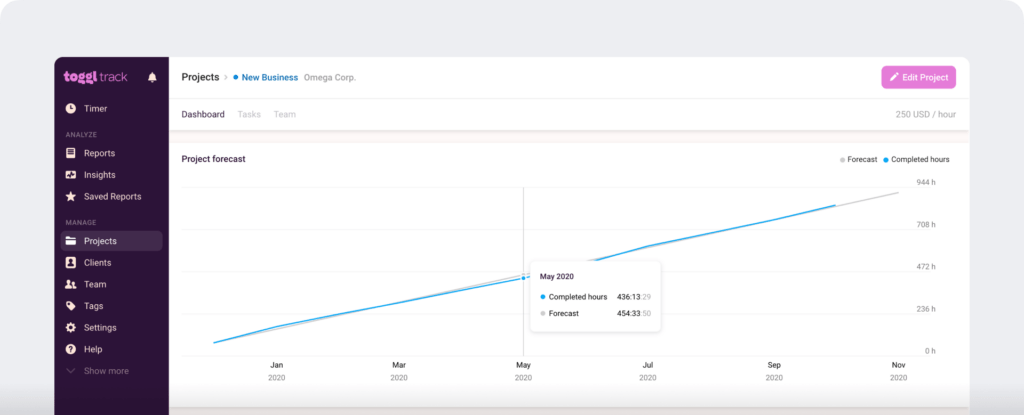
B. Timely
Timely also offers project management and budgeting features. It:
- Allows you to set time and labor cost budgets for different projects.
- Sends notifications when projects approach budgets.
- Provides a record of expenses for past projects to create more accurate future budgets.
- Offers drag-and-drop task allocation and team calendar sync.
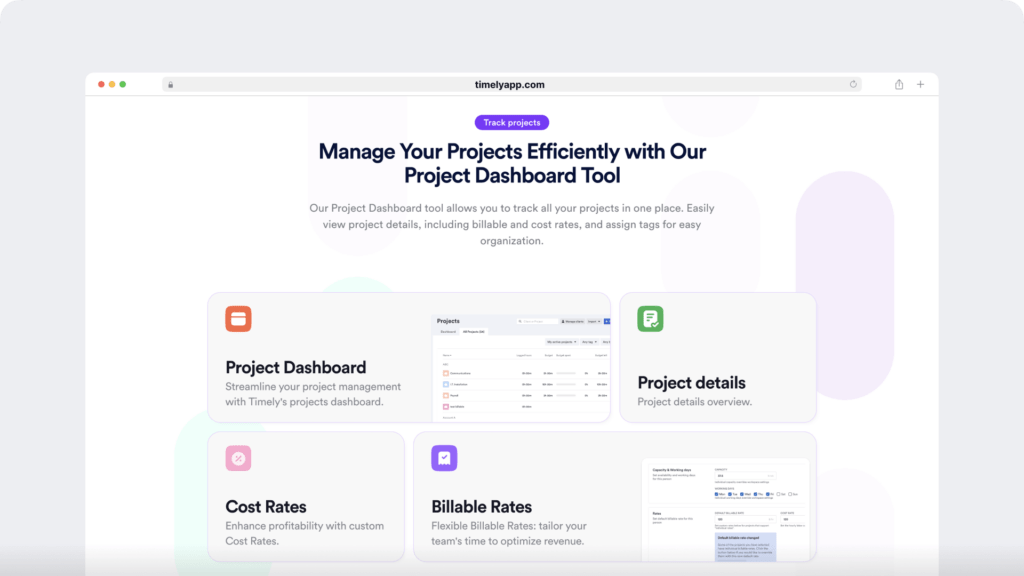
Summary: Project management
Both Toggl and Timely offer expense tracking and budgeting for managing project health. Timely takes the cake in terms of teamwork features, like the task allocation and team calendar.
3. Reporting
Reporting is one of the most crucial features of any time tracking software. Reports can turn your employees’ time and activity data into actionable insights to improve your productivity, time management, and profitability.
Let’s see how Toggl and Timely reports compare:
A. Toggl
Toggl Track allows you to create three kinds of customizable reports:
- Detailed reports: Shows every time entry that applies to your chosen date range and filters (users, teams, clients, projects, tasks, etc.).
- Weekly reports: Gives an overview of your work hours tracked and earnings in a week. You can apply filters and group by project or user.
- Summary reports: Provides a broad overview of time tracked. You can filter and group the data as well as create bar charts (e.g., A bar showing total hours tracked, split into billable and non-billable hours).
Additionally, Toggl allows you to:
- Export reports as CSV (Excel spreadsheets) or PDF files.
- Save reports and share them with clients.
- Schedule regular reports to be emailed to team leaders.
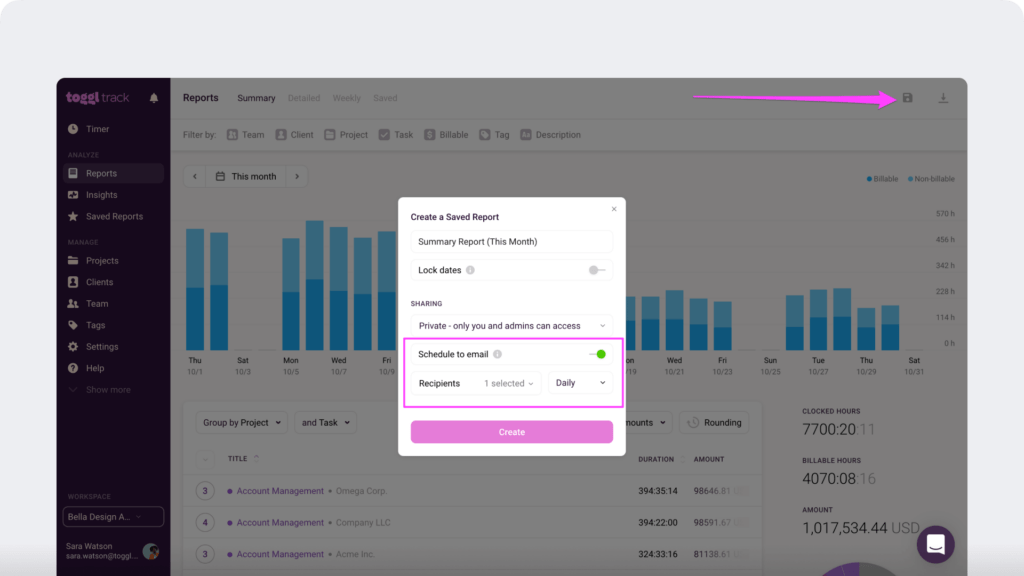
B. Timely
With Timely, you can create custom reports by filtering your data, or use report templates to start you off. You can also save your custom reports as new templates.
To make a report, you can filter according to:
- Date range.
- Users.
- Clients.
- Projects.
- Tags (task categories).
- Billable hours, non-billable hours, or both.
You can then include a bar, donut, or table chart in your report.
Timely also allows you to:
- Customize reports with your branding.
- Choose between Live (real-time) or Snapshot (static) designs.
- Save reports to be shared with clients via a public URL link.
- Export reports as XLS, CSV, or PDF files.
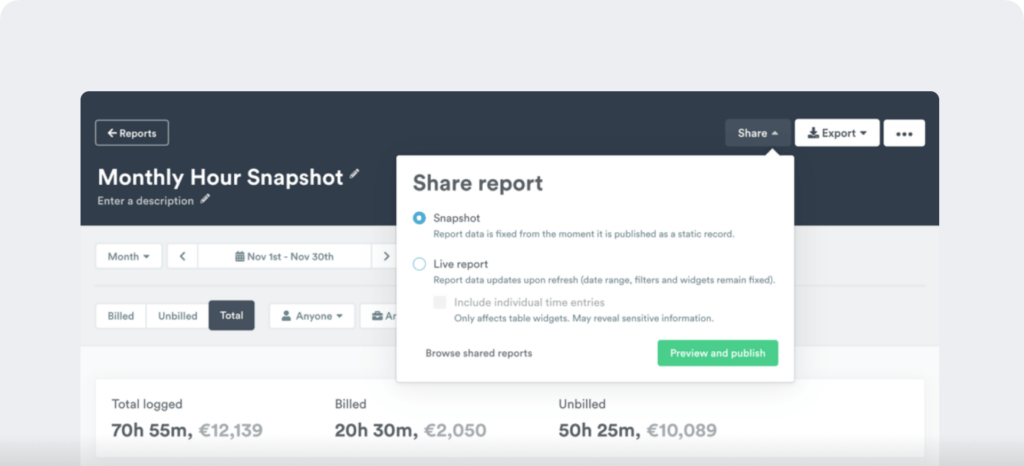
Summary: Reporting
Both tools allow you to create custom reports by filtering and grouping. Timely also offers live designs, company branding, and templates.
4. Integrations
Here’s an overview of how each software can integrate with other apps you may use:
A. Toggl
Toggl Track offers 10 native integrations with apps like Asana and Jira. It also provides a browser extension that allows you to control the timer in over 100 compatible apps, including Slack, Basecamp, and GitHub.
You can also use the Toggl API to build more app connections. Or, browse the library of integrations pre-built by the Toggl Track API user community.
Additionally, Toggl integrates with some automation apps, like Zapier, to create interactions between thousands of compatible apps. For instance, although Toggl doesn’t integrate with Quickbooks Online, you can use Zapier to onboard new clients into Quickbooks and Toggl simultaneously.
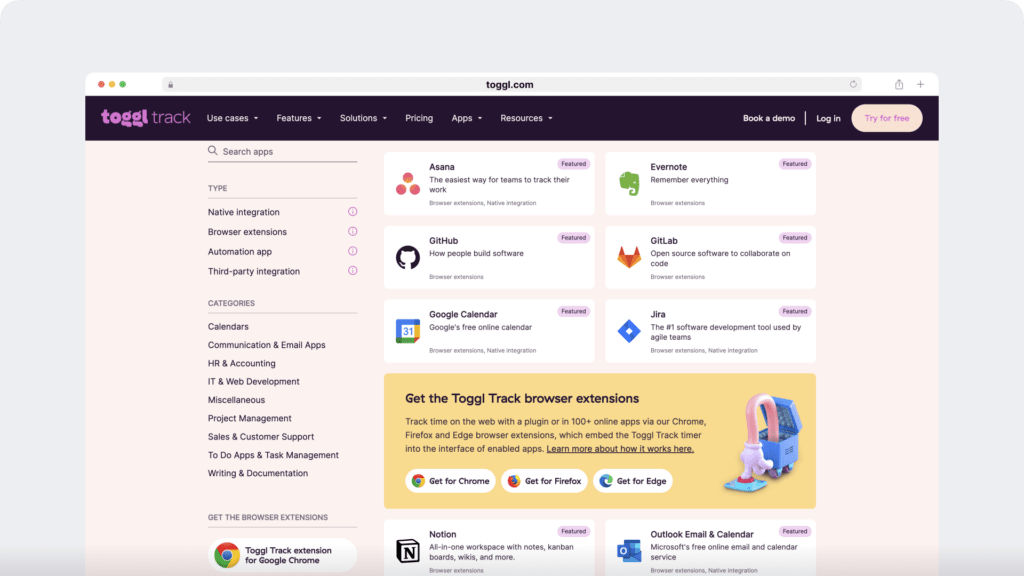
B. Timely
Timely offers 15 native integrations with apps like Trello, Office 365 (Microsoft Word, Excel, etc.), Jira, and GitHub.
It also offers a Zapier integration to build further connections. For example, you can create time entries based on Google Calendar events. Or, connect Timely to a project management tool with which the time tracker doesn’t integrate, such as Wrike.
In addition, Timely integrates with Toggl, allowing you to import your user profiles, clients, projects, and tasks. This makes it easy to change over to Timely.
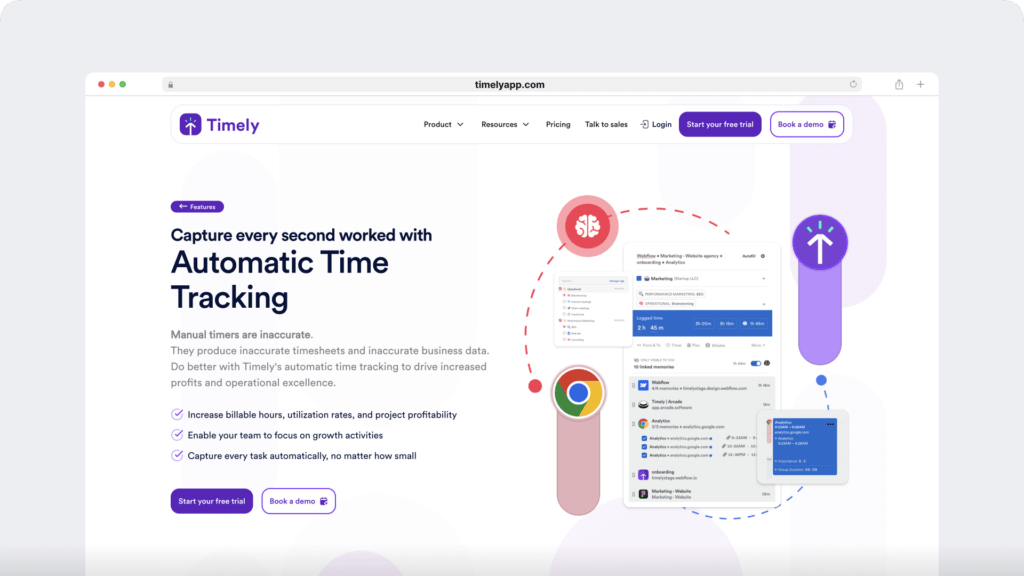
Summary: Integrations
Toggl Track offers more integrations than Timely due to the inclusion of a browser extension and multiple automation app integrations (like Zapier). However, Timely integrates with Toggl to allow you to change tools.
5. Pricing
Here’s an overview of the pricing structures of Toggl and Timely:
A. Toggl
Toggl Track offers a free plan with limited features for up to 5 users.
The starting price for a paid plan is $10/user per month for unlimited projects and clients.
B. Timely
Timely doesn’t have a free version but offers a free 14-day trial of the Unlimited plan.
The Starter paid plan pricing is $10/user per month for 50 projects and three teams.
Summary: Pricing
Both tools start at $10/user per month. However, Toggl, unlike Timely, offers a free plan and unlimited projects in the Starter plan.
Think you’re ready to choose?
Before you make a purchasing decision, let’s look at some of the drawbacks of these time tracking tools.
3 key limitations of Toggl and Timely
Here are some obstacles you could encounter when using Toggl or Timely:
- Lack of idle time tracking: Neither tool allows you to track employee idle time (inactivity). Without tracking inactive time, you can’t fully understand your team members’ activity and productivity levels. You’ll also struggle to differentiate between billable hours and non-billable hours, which may lead to inaccurate client invoices.
- No productivity ratings: Another productivity management feature these tools lack is the ability to mark web and app usage as productive or unproductive. Without productivity ratings, you won’t know if your team is working on leisure apps or work apps. It’ll also negatively impact accountability in your workplace.
- Limited payroll features: Neither tools offer integrations to run payroll within the time tracking software. You’d have to pay employees manually or export your payroll data to another software to make the payments. This adds an extra step to your payroll management process. Additionally, you may need to pay an extra fee to use third-party payroll software.
So, is there a tool that can fill in the gaps and provide excellent time tracking too?
Yes! Introducing: Time Doctor.
A better time and productivity tracking alternative: Time Doctor
Time Doctor is a robust software used by large companies like Ericsson, as well as small businesses like Thrive market. It’s also perfect for a freelancer or remote team.
This app has all the functionalities of a superb time tracker and a productivity app. That’s because it also tracks and encourages efficiency. What’s more, you can generate and run payroll right from the app.
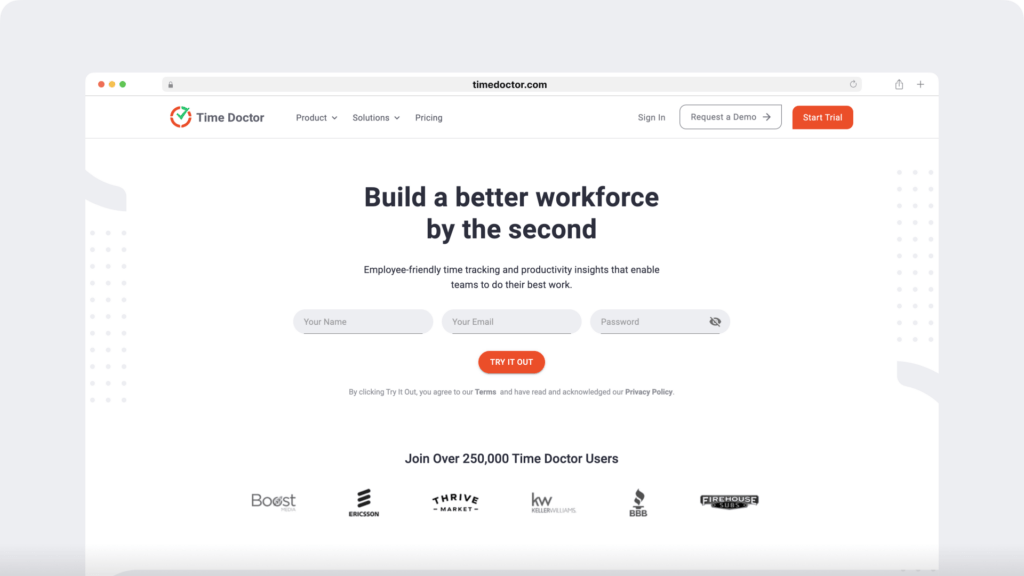
Here are some of Time Doctor’s best features:
- Flexible time tracking:
For greater ease of use, Time Doctor offers two ways to track time.
- Interactive mode: A manual timer employees can start and stop to build their daily timesheet.
- Silent mode: An automatic tracker that runs in the background while employees tend to their workflow uninterrupted. This also ensures that team members never forget to start or stop the timer to track time.
- Idle time tracking: The time tracking software can detect keyboard and mouse usage to determine whether employees are active or inactive. It also calculates the percentage of idle time in an hour or selected period.
If an employee is inactive for too long, the app displays a pop-up notification asking if they’re still working. It automatically stops the timer if the user doesn’t interact.
- Customizable productivity ratings: Time Doctor assigns a productivity rating to all websites and applications (Productive, Unproductive, Neutral, or Unrated). You can customize these ratings globally or for specific teams and employees (e.g., set Facebook as unproductive across the board but productive for marketers.)
- Screenshots and screencasts (optional feature): Receive timed screenshots and screen recordings of employee devices to ensure they’re working responsibly. These can be blurred or deleted for privacy.
- Detailed reports: Time Doctor can generate a variety of automated reports to give you valuable time and productivity insights, such as:
- Hours Tracked Reports: Calculates the total working hours users tracked in a day, week, or date range.
- Projects & Tasks Reports: Displays time tracked for different projects, clients, and tasks.
- Activity Summary Reports: Shows the share of time employees spent active or unproductive, manually submitted time, and tracked time on mobile time tracked.
- Web & App Usage Reports: Provides a record of time employees track on different websites and applications.
You can also create custom reports to suit your business needs and export them as CSV (Excel Spreadsheets) or PDF files to share with stakeholders and clients.
- Payroll integrations: Time Doctor uses billable rates and billable hours tracked to generate an accurate payroll.
It integrates with several payment apps (like PayPal, ADP, Gusto, and Wise) to pay employees right from the app.
You can customize the payroll in terms of pay period, currency, monthly salary vs rate per hour, and bulk or individual payments.
In addition, Time Doctor also lets you:
- Track time online and offline.
- Set up Work Schedules and track attendance and punctuality.
- Utilize the Chrome extension to integrate Time Doctor with 60+ other apps (such as Asana, Trello, and GitHub).
- Build further app integrations using the Time Doctor API.
- Use Time Doctor as a desktop app (Windows, Mac, Linux), mobile app (Android), or web app online.
Time Doctor offers a free 14-day trial (no credit card required). Paid plans start at $7/user per month.
Check out Time Doctor’s full features list to see what else it can do!
Wrapping up
Both Toggl Track and Timely are suitable for tracking employee time and project expenses. However, they do have some drawbacks, including a lack of payroll integrations and productivity management features.
When deciding between Toggle and Timely, you can use this guide to help you understand the major differences between the two.
The best time tracking app should combine the features of a time tracking tool, task management software, productivity app, and payroll solution. If that sounds enticing, Time Doctor may be the software for you.
Why not try Time Doctor’s 14-day free trial today?


